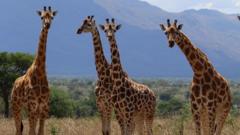In a significant development for the understanding of one of nature's most iconic creatures, scientists from the International Union for Conservation of Nature (IUCN) have officially recognized three additional species of giraffes. While previously thought to consist of only one species, new research indicates that there are now four distinctive groups of giraffes, prompting a reevaluation of their conservation status.
The study employed a meticulous analysis of skull sizes and head shapes across giraffe populations, revealing considerable genetic diversity that justified classifying these groups as separate species. Researchers focused on geographical barriers like rivers, mountains, and ecosystems that may have contributed to the distinct evolution of these giraffes across Africa.
Among the newly identified species is the Southern giraffe, which inhabits regions including Angola, southern Botswana, Namibia, and parts of Mozambique. The Kunene and Zambezi rivers, along with the Congo Basin's rainforests, have isolated these giraffes, promoting their evolutionary development.
Another species recognized is the Reticulated giraffe, found in Kenya, Somalia, and Ethiopia. Its separation from other giraffes has been largely attributed to natural landmarks such as the Tana River and surrounding mountains.
The Northern giraffe, residing in areas of western Ethiopia, central Kenya, and Uganda, is also officially classified as a separate species. Its population is distinguished by its migratory patterns and the geographical divisions created by the Nile River and Lake Victoria.
Finally, the Masai giraffe, characterized by its unique leaf-patterned coat, is recognized as a distinct group further divided from the Northern giraffe by natural barriers.
This major classification update comes with implications for conservation strategies. Previously, giraffes were identified as a single vulnerable species, but the IUCN aims to reassess the threats faced by these new classifications and enhance protective measures accordingly. According to IUCN co-author Michael Brown, developing an in-depth understanding of giraffe taxonomy is crucial to effectively manage and conserve diverse populations of these majestic mammals.























